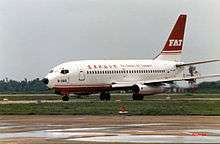Far Eastern Air Transport Flight 103
 A Far Eastern Air Transport Boeing 737-200 similar to the one involved | |
| Accident | |
|---|---|
| Date | 22 August 1981 |
| Summary | Metal fatigue cracking and severe corrosion, leading to explosive decompression and in-flight break-up |
| Site | Near Sanyi Township, Miaoli County, Taipei |
| Aircraft | |
| Aircraft type | Boeing 737-222 |
| Operator | Far Eastern Air Transport |
| IATA flight No. | FE103 |
| ICAO flight No. | FEA103 |
| Call sign | FAR EASTERN 103 |
| Registration | B-2603 |
| Flight origin | Taipei Songshan Airport |
| Destination | Kaohsiung International Airport |
| Occupants | 110 |
| Passengers | 102 |
| Crew | 8 |
| Fatalities | 110 |
| Survivors | 0 |
Far Eastern Air Transport Flight 103 was a flight from Taiwan Taipei Songshan Airport to Kaohsiung International Airport flight that crashed on 22 August 1981, killing all 110 people on board. The Boeing 737-222 aircraft disintegrated in mid-air and crashed in Sanyi Township Miaoli County mountain Village double pit area. It is also called the Sanyi Air Disaster. The crash is the second-deadliest aviation accident on Taiwanese soil, behind China Airlines Flight 676.
Aircraft
- Aircraft model: Boeing 737-222
- Manufacturing serial number (msn): 19939/151
- Registration: B-2603(formerly owned by United Airlines as N9058U)
- Year of manufacture: 1969
Summary
The B-2603 aircraft flew from Taipei to Wuhu on the same day. 10 minutes after takeoff, the cabin pressure was lost, so it flew back to Taipei for overhaul an repairs. After the repairs, flight 103 was carried out from Taipei Songshan Airport to Kaohsiung International Airport. 14 minutes after take-off, the aircraft disintegrated. The nose crashed in Sanyi Township, Miaoli County. Other debris crashed in Tonglu County, Yuanli Town and Tongyu County. The people on board consisted of 6 crew members and 104 passengers. The passengers included Zhou Shiguang, the representative of the First National Congress of Dongjiang County, and Japanese writer Kuniko Mukōda. there were 90 Taiwanese, 18 Japanese and 2 Americans on board the flight. After the accident, because the area is a mountainous area, the road traffic became inconvenient, and the remains of the victims are transported by road to the Shengxing railway station and then transported by train.[1][2]
Cause
On 5 August 1981, when the plane flew from Taipei to Kaohsiung, there was also a situation in which the cabin lost pressure. After the investigation, it was found that the skin on the fuselage was severely corroded, causing the entire fuselage to rupture and disintegrate.
Aftermath
After the crash, Far Eastern Air Transport stopped using discontinued using flight numbers 103 and 104 (also involved in an accident); although they were resumed some time after, but in September 2007 the airline discontinued their use again, due to the Taiwan High Speed Rail traffic's impact on the Taipei - Kaohsiung route.
Victims
| Nationality | Passengers | Crew | Total |
|---|---|---|---|
| 82 | 8 | 90 | |
| 19 | 0 | 19 | |
| 2 | 0 | 2 |
Notable victims
See also
References
- ↑ "AIRLINER THAT CRASHED IN TAIWAN, KILLING 110, HAD PRESSURE SNAGS." Associated Press at The New York Times. Sunday 23 August 1981. Late City Final Edition, Section 1, Page 3, Column 1. Retrieved on 6 January 2012.
- ↑ "U.S. Experts to Probe Crash." Associated Press at the Sarasota Herald-Tribune. Sunday 30 August 1981. 3A. Retrieved on 6 January 2012.